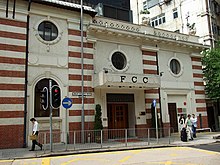 The northern end of Ice House Street, near the junction with
Chater Road.
Connaught Road can be seen one
block beyond Chater. | |
| Native name | 雪廠街 ( Yue Chinese) |
|---|---|
| Length | 550 m (1,800 ft) [1] |
| Location | Central, Hong Kong |
| South end | Lower Albert Road |
| North end | Connaught Road Central |
| Ice House Street | |||||||||||
|---|---|---|---|---|---|---|---|---|---|---|---|
| Traditional Chinese | 雪廠街 | ||||||||||
| Simplified Chinese | 雪厂街 | ||||||||||
| |||||||||||


Ice House Street ( Chinese: 雪廠街; Jyutping: syut3 chong2 gaai1) is a one-way street in Central, Hong Kong Island, Hong Kong. Named after the structure previously located on it that housed the city's only source of ice, it stretches from Lower Albert Road to Connaught Road. The street is noted for several historical landmarks situated on it, most notably the Club Lusitano and the Old Dairy Farm Depot.
History
During the First Opium War, the British occupied Hong Kong in 1841 and one year later, the territory was ceded to them in the Treaty of Nanking. Four years later, in 1845, the Hong Kong Ice Company was founded. [2] It was set up with the intention of selling ice blocks [2] from the United States [3]—specifically from New England and New York State. [4] These were transported to the colony on clippers and traded as a commodity. [5] To persuade the company to sell ice to local hospitals at cost price, the Government of Hong Kong granted the company the site for an ice house rent-free for 75 years. [2] The building eventually lent its name to the street it was situated on; it was Hong Kong's only source of ice, because that there were no "commercial ice-making facilities" in the colony. [3] The house was on the intersection of Ice House Street and Queen's Road Central, and continued to store ice imports until 1874, when ice production started in Causeway Bay. [2]
Description and features

From its southern end, Ice House Street begins at its junction with Lower Albert Road. [3] This is where the Old Dairy Farm Depot is located. [6] Built by Dairy Farm, one of the first companies that sold ice cream and refrigerated milk in the city, [7] it currently houses the Hong Kong Fringe Club and the Foreign Correspondents' Club. Although not officially on the street itself, the Bishop's House is situated across from the depot [6] and overlooks it from an elevated vantage point. [2] It serves as the residence of the Archbishop of Hong Kong (Anglican). The next landmark on the route is the flight of stairs that descend onto Duddell Street and contain four gas lamps from the 1870s that are declared monuments. [6] Before the street intersects with Queen's Road Central, it passes the Club Lusitano. The club, which is the meeting point for Portuguese expatriates in the city, has been located on the site since 1920 [8] when it moved down from its original 1866 site in Shelly Street. The building has since been reconstructed twice, in 1967 and 1996-2002 [9]
After crossing with Queen's Road, Ice House Street goes past 9 Queen's Road Central. Although the current skyscraper is located in the same place as a former building that stood on the site until 1987, the old complex's address was 9 Ice House Street. [10] The street then intersects with Des Voeux Road Central and Chater Road before ending on Connaught Road Central. [6]
Other features
Other buildings located along the street include:
- Former Central Government Offices West Wing – 11 Ice House Street
- Alexandra House and Prince's Building, between Des Voeux Road Central and Chater Road
- Mandarin Oriental, between Chater Road and Connaught Road Central
Major intersections
The entire route is in Central, Central and Western District.
| km [1] | mi | Destinations | Notes | ||
|---|---|---|---|---|---|
| 0.00 | 0.00 | Lower Albert Road | Southern terminus at one way street | ||
| 0.27 | 0.17 | Queen's Road Central | |||
| 0.40 | 0.25 | Des Voeux Road | |||
| 0.55 | 0.34 |
Connaught Road to | Northern terminus at one way street | ||
| 1.000 mi = 1.609 km; 1.000 km = 0.621 mi | |||||
See also
References
- ^ a b Google (17 November 2013). "Ice House Street" (Map). Google Maps. Google. Retrieved 17 November 2013.
- ^ a b c d e Wordie, Jason (1 March 2002). Streets: Exploring Hong Kong Island. Hong Kong University Press. pp. 46–47. ISBN 9789622095632. Retrieved 16 November 2013.
- ^ a b c Brown, Jules (2002). Hong Kong and Macau. Rough Guides. p. 66. ISBN 9781858288727. Retrieved 16 November 2013.
- ^ Greenway, H.D.S. (4 September 2007). "Change is carved in stone". The Boston Globe. Retrieved 16 November 2013.
- ^ Boyd, L.M. (12 June 1997). "In Antarctica the flies are walkers". The Victoria Advocate. p. 13A. Retrieved 16 November 2013.
- ^ a b c d Stone, Andrew; Chen, Piera; Chow, Chung Wah (2010). Hong Kong & Macau. Lonely Planet. pp. 78–79. ISBN 9781741792256. Retrieved 16 November 2013.
- ^ Terry, Edith (2 February 2005). "History in the making". South China Morning Post. p. 15. Retrieved 16 November 2013. (subscription required)
- ^ "HISTORY". Club Lusitano. Retrieved 27 November 2019.
- ^ "HISTORY". Club Lusitano. Retrieved 27 November 2019.
- ^ Yu, Patrick Shuk-siu (1 June 2002). Tales from No.9 Ice House Street. Hong Kong University Press. p. 29. ISBN 9789622095809. Retrieved 16 November 2013.